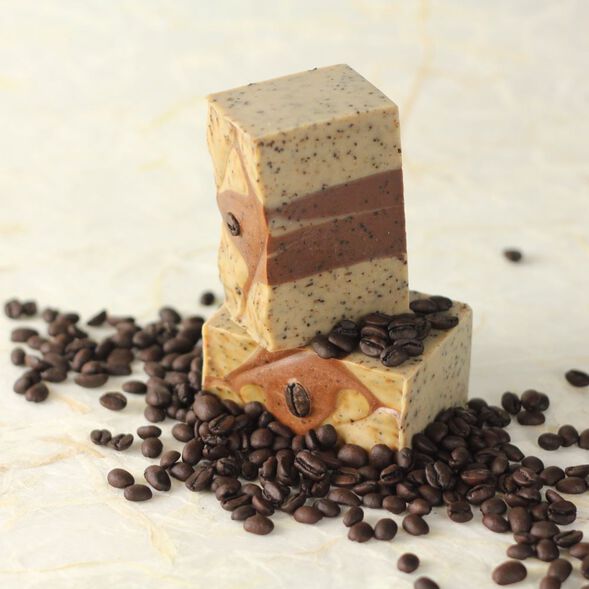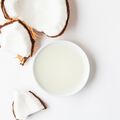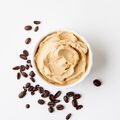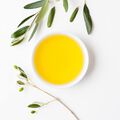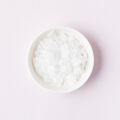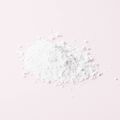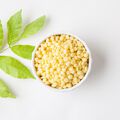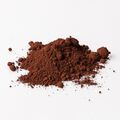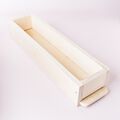
Espresso Shot Cold Process Soap Project
- Skill Level:
- Time: 30 minutes
- Yield: null
Project Description
In the Pacific Northwest, there's a coffee shop on every corner (sometimes two!), and a never-ending thirst for the latest and greatest new drink. The passion for coffee spills over into passion for soap making. When we brought in the Espresso Fragrance Oil, we went to work designing the most coffee-tastic soap we could.
Espresso Fragrance Oil is a true coffee scent. Whereas Caffe Latte Fragrance Oil has hints of sweetness and cream and Coffee Shop Fragrance Oil smells just like walking into a Pacific Northwest cafe, this project is for the coffee purist. Along with a recipe that includes coffee butter and real coffee grounds, this is the ultimate soap for coffee lovers everywhere.
You will need:
- 5 lb. Wood Mold with Silicone Liner
- 2 Sturdy Cardboard Sheets
- 5.5 oz. Cocoa Butter
- 13.7 oz. Coconut Oil
- 2.7 oz. Coffee Butter
- 2.7 oz. Sweet Almond Oil
- 16.5 oz. Olive Oil
- 13.7 oz. Palm Oil
- 7.7 oz. Sodium Hydroxide
- 18.1 oz. Distilled Water
- Brown Oxide
- Titanium Dioxide
- 3.5 oz. Espresso Fragrance Oil
- 3 Tbsp. Coffee Grounds
COLOR PREP: Disperse 1 teaspoon of the titanium dioxide into 1 tablespoon of sunflower or sweet almond oil (or any other liquid oil). Then, disperse 1 teaspoon of brown oxide into 1 tablespoon of light liquid oil. Use a mini mixer to get the clumps of color worked out smoothly. Optional: To ensure the titanium dioxide blends smoothly into the soap batter, we recommend micronizing it before dispersing it in oil. Use a coffee grinder to break up any clumps of color and prevent streaks of white from showing in the final soap. We like to use a coffee grinder that has a removable stainless steel mixing area for easy cleaning.
TOOL PREP: Cut the cardboard sheets to fit into the mold lengthwise and place into the mold to divide it into three even sections. Set aside.
COFFEE GROUNDS: You can use either dry or used coffee grounds for this project. If you do use dry grounds like we did, be aware that they may “bleed” and form a small halo of color around them. If you don’t want the halo effect, make yourself a pot of joe and use the leftover grounds.
SAFETY FIRST: Suit up for safe handling practices. That means goggles, gloves, and long sleeves. Make sure kids, pets, other distractions, and tripping hazards are out of the house or don’t have access to your soaping space. Always soap in a well-ventilated area.
Follow these steps:
1
Slowly and carefully add 7.7 ounces of lye to 18.1 ounces of water and gently stir until the lye has fully dissolved and the liquid is clear. Set aside to cool.
2
Combine 5.5 ounces of cocoa butter, 13.7 ounces of coconut oil, 2.7 ounces of coffee butter, 2.7 ounces of sweet almond oil, 16.5 ounces of olive oil, and 13.7 ounces of palm oil (remember to fully melt then mix your entire container of palm oil before portioning). Once the lye water and the oils have cooled to 130° F or below (and are ideally within 10 degrees of each other), add the lye water to the oils and stick blend until thin trace. If you’d like a harder bar of soap that releases faster from the mold, you can add sodium lactate to the cooled lye water. Use 1 teaspoon of sodium lactate per pound of oils in the recipe. For this recipe, you’d add about 3 tsp. sodium lactate.
3
Once the batter has reached a light trace, pour 3 cups into a separate container.
4
Add 1 tablespoon of coffee grounds into the small container, and 2 tablespoons into the larger container. Use a whisk to gently combine.
5
Add 3 teaspoons of the dispersed titanium dioxide into the large container. Use a whisk to mix in.
6
Add 3 teaspoons of dispersed brown oxide to the small container, and use a whisk to thoroughly combine.
7
Add half of the Espresso Fragrance Oil to the small container, and half to the large container. You can eyeball it, but if you want to be exact then add 1.7 ounces of fragrance to each container. Use a whisk to mix in.
8
Gently pour the brown soap into the center of the sectioned mold. To help the soap batter evenly spread throughout the middle section, you can alternate pouring from each end.
9
Once the center section is full, pour the white batter into the outside sections.
10
Pour slowly, and alternate pouring into different ends to evenly disperse the batter in the mold.
11
Once the mold is full, slowly pull the long cardboard dividers straight up, and set aside.
12
Once all the pieces have been removed, tap the soap mold firmly on the table to smooth out the sections and release any air bubbles. Beginning in the corner of the mold, insert a wooden chopstick or dowel to the bottom of the mold and make a zig-zag pattern at a 45 degree angle down the length of the mold.
13
Once you have created the zig-zag down the length of the mold once, it’s time to go back and do it again! Starting on the opposite corner on the same end of the mold you began with the first time, use your chopstick or dowel to cross through the existing lines, creating an argyle-like pattern.
14
Gently place whole coffee beans in the center of each swirl. Spray with 99% isopropyl alcohol to prevent soda ash.
15
Allow the soap to sit in the mold for 3-4 days before unmolding. Cut soap between the coffee beans, so they are in the center of each bar. Allow the soap to cure for 4-6 weeks and enjoy!
Tutorial credits
Photographer: Amanda Kerzman

Espresso Shot Cold Process Soap Project
- Skill Level:
- Time: 30 minutes
- Yield: null
Project Description
In the Pacific Northwest, there's a coffee shop on every corner (sometimes two!), and a never-ending thirst for the latest and greatest new drink. The passion for coffee spills over into passion for soap making. When we brought in the Espresso Fragrance Oil, we went to work designing the most coffee-tastic soap we could.
Espresso Fragrance Oil is a true coffee scent. Whereas Caffe Latte Fragrance Oil has hints of sweetness and cream and Coffee Shop Fragrance Oil smells just like walking into a Pacific Northwest cafe, this project is for the coffee purist. Along with a recipe that includes coffee butter and real coffee grounds, this is the ultimate soap for coffee lovers everywhere.
You will need:
- 5 lb. Wood Mold with Silicone Liner
- 2 Sturdy Cardboard Sheets
- 5.5 oz. Cocoa Butter
- 13.7 oz. Coconut Oil
- 2.7 oz. Coffee Butter
- 2.7 oz. Sweet Almond Oil
- 16.5 oz. Olive Oil
- 13.7 oz. Palm Oil
- 7.7 oz. Sodium Hydroxide
- 18.1 oz. Distilled Water
- Brown Oxide
- Titanium Dioxide
- 3.5 oz. Espresso Fragrance Oil
- 3 Tbsp. Coffee Grounds
COLOR PREP: Disperse 1 teaspoon of the titanium dioxide into 1 tablespoon of sunflower or sweet almond oil (or any other liquid oil). Then, disperse 1 teaspoon of brown oxide into 1 tablespoon of light liquid oil. Use a mini mixer to get the clumps of color worked out smoothly. Optional: To ensure the titanium dioxide blends smoothly into the soap batter, we recommend micronizing it before dispersing it in oil. Use a coffee grinder to break up any clumps of color and prevent streaks of white from showing in the final soap. We like to use a coffee grinder that has a removable stainless steel mixing area for easy cleaning.
TOOL PREP: Cut the cardboard sheets to fit into the mold lengthwise and place into the mold to divide it into three even sections. Set aside.
COFFEE GROUNDS: You can use either dry or used coffee grounds for this project. If you do use dry grounds like we did, be aware that they may “bleed” and form a small halo of color around them. If you don’t want the halo effect, make yourself a pot of joe and use the leftover grounds.
SAFETY FIRST: Suit up for safe handling practices. That means goggles, gloves, and long sleeves. Make sure kids, pets, other distractions, and tripping hazards are out of the house or don’t have access to your soaping space. Always soap in a well-ventilated area.
Follow these steps:
1
Slowly and carefully add 7.7 ounces of lye to 18.1 ounces of water and gently stir until the lye has fully dissolved and the liquid is clear. Set aside to cool.
2
Combine 5.5 ounces of cocoa butter, 13.7 ounces of coconut oil, 2.7 ounces of coffee butter, 2.7 ounces of sweet almond oil, 16.5 ounces of olive oil, and 13.7 ounces of palm oil (remember to fully melt then mix your entire container of palm oil before portioning). Once the lye water and the oils have cooled to 130° F or below (and are ideally within 10 degrees of each other), add the lye water to the oils and stick blend until thin trace. If you’d like a harder bar of soap that releases faster from the mold, you can add sodium lactate to the cooled lye water. Use 1 teaspoon of sodium lactate per pound of oils in the recipe. For this recipe, you’d add about 3 tsp. sodium lactate.
3
Once the batter has reached a light trace, pour 3 cups into a separate container.
4
Add 1 tablespoon of coffee grounds into the small container, and 2 tablespoons into the larger container. Use a whisk to gently combine.
5
Add 3 teaspoons of the dispersed titanium dioxide into the large container. Use a whisk to mix in.
6
Add 3 teaspoons of dispersed brown oxide to the small container, and use a whisk to thoroughly combine.
7
Add half of the Espresso Fragrance Oil to the small container, and half to the large container. You can eyeball it, but if you want to be exact then add 1.7 ounces of fragrance to each container. Use a whisk to mix in.
8
Gently pour the brown soap into the center of the sectioned mold. To help the soap batter evenly spread throughout the middle section, you can alternate pouring from each end.
9
Once the center section is full, pour the white batter into the outside sections.
10
Pour slowly, and alternate pouring into different ends to evenly disperse the batter in the mold.
11
Once the mold is full, slowly pull the long cardboard dividers straight up, and set aside.
12
Once all the pieces have been removed, tap the soap mold firmly on the table to smooth out the sections and release any air bubbles. Beginning in the corner of the mold, insert a wooden chopstick or dowel to the bottom of the mold and make a zig-zag pattern at a 45 degree angle down the length of the mold.
13
Once you have created the zig-zag down the length of the mold once, it’s time to go back and do it again! Starting on the opposite corner on the same end of the mold you began with the first time, use your chopstick or dowel to cross through the existing lines, creating an argyle-like pattern.
14
Gently place whole coffee beans in the center of each swirl. Spray with 99% isopropyl alcohol to prevent soda ash.
15
Allow the soap to sit in the mold for 3-4 days before unmolding. Cut soap between the coffee beans, so they are in the center of each bar. Allow the soap to cure for 4-6 weeks and enjoy!
Tutorial credits
Photographer: Amanda Kerzman
You will need:
- 5 lb. Wood Mold with Silicone Liner
- 2 Sturdy Cardboard Sheets
- 5.5 oz. Cocoa Butter
- 13.7 oz. Coconut Oil
- 2.7 oz. Coffee Butter
- 2.7 oz. Sweet Almond Oil
- 16.5 oz. Olive Oil
- 13.7 oz. Palm Oil
- 7.7 oz. Sodium Hydroxide
- 18.1 oz. Distilled Water
- Brown Oxide
- Titanium Dioxide
- 3.5 oz. Espresso Fragrance Oil
- 3 Tbsp. Coffee Grounds
COLOR PREP: Disperse 1 teaspoon of the titanium dioxide into 1 tablespoon of sunflower or sweet almond oil (or any other liquid oil). Then, disperse 1 teaspoon of brown oxide into 1 tablespoon of light liquid oil. Use a mini mixer to get the clumps of color worked out smoothly. Optional: To ensure the titanium dioxide blends smoothly into the soap batter, we recommend micronizing it before dispersing it in oil. Use a coffee grinder to break up any clumps of color and prevent streaks of white from showing in the final soap. We like to use a coffee grinder that has a removable stainless steel mixing area for easy cleaning.
TOOL PREP: Cut the cardboard sheets to fit into the mold lengthwise and place into the mold to divide it into three even sections. Set aside.
COFFEE GROUNDS: You can use either dry or used coffee grounds for this project. If you do use dry grounds like we did, be aware that they may “bleed” and form a small halo of color around them. If you don’t want the halo effect, make yourself a pot of joe and use the leftover grounds.
SAFETY FIRST: Suit up for safe handling practices. That means goggles, gloves, and long sleeves. Make sure kids, pets, other distractions, and tripping hazards are out of the house or don’t have access to your soaping space. Always soap in a well-ventilated area.
Follow these steps:
1
Slowly and carefully add 7.7 ounces of lye to 18.1 ounces of water and gently stir until the lye has fully dissolved and the liquid is clear. Set aside to cool.
2
Combine 5.5 ounces of cocoa butter, 13.7 ounces of coconut oil, 2.7 ounces of coffee butter, 2.7 ounces of sweet almond oil, 16.5 ounces of olive oil, and 13.7 ounces of palm oil (remember to fully melt then mix your entire container of palm oil before portioning). Once the lye water and the oils have cooled to 130° F or below (and are ideally within 10 degrees of each other), add the lye water to the oils and stick blend until thin trace. If you’d like a harder bar of soap that releases faster from the mold, you can add sodium lactate to the cooled lye water. Use 1 teaspoon of sodium lactate per pound of oils in the recipe. For this recipe, you’d add about 3 tsp. sodium lactate.
3
Once the batter has reached a light trace, pour 3 cups into a separate container.
4
Add 1 tablespoon of coffee grounds into the small container, and 2 tablespoons into the larger container. Use a whisk to gently combine.
5
Add 3 teaspoons of the dispersed titanium dioxide into the large container. Use a whisk to mix in.
6
Add 3 teaspoons of dispersed brown oxide to the small container, and use a whisk to thoroughly combine.
7
Add half of the Espresso Fragrance Oil to the small container, and half to the large container. You can eyeball it, but if you want to be exact then add 1.7 ounces of fragrance to each container. Use a whisk to mix in.
8
Gently pour the brown soap into the center of the sectioned mold. To help the soap batter evenly spread throughout the middle section, you can alternate pouring from each end.
9
Once the center section is full, pour the white batter into the outside sections.
10
Pour slowly, and alternate pouring into different ends to evenly disperse the batter in the mold.
11
Once the mold is full, slowly pull the long cardboard dividers straight up, and set aside.
12
Once all the pieces have been removed, tap the soap mold firmly on the table to smooth out the sections and release any air bubbles. Beginning in the corner of the mold, insert a wooden chopstick or dowel to the bottom of the mold and make a zig-zag pattern at a 45 degree angle down the length of the mold.
13
Once you have created the zig-zag down the length of the mold once, it’s time to go back and do it again! Starting on the opposite corner on the same end of the mold you began with the first time, use your chopstick or dowel to cross through the existing lines, creating an argyle-like pattern.
14
Gently place whole coffee beans in the center of each swirl. Spray with 99% isopropyl alcohol to prevent soda ash.
15
Allow the soap to sit in the mold for 3-4 days before unmolding. Cut soap between the coffee beans, so they are in the center of each bar. Allow the soap to cure for 4-6 weeks and enjoy!
Tutorial credits
Photographer: Amanda Kerzman

